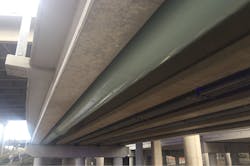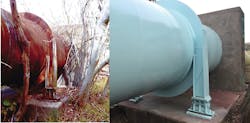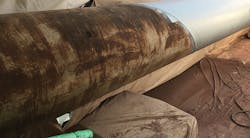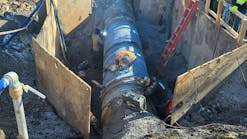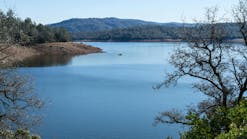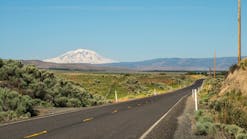Weld seam brush coating on 60-inch water line.
In 2012, the city's corrosion engineering consultant inspected every above-grade crossing to determine the condition of the existing coating, and determine if hazardous materials, including heavy metals and asbestos, were present. Of the crossings that were inspected, various types of coatings were found, including paint, tape wrap and coal tar enamel.
During this study, more than 200 crossings were identified for rehabilitation or replacement, with 21 of these crossings being 24 inches in diameter and larger. In 2014, as part of the city's Surface Water Transmission Program (SWTP), Lockwood, Andrews & Newnam Inc. (LAN), a planning, engineering and program management firm, was hired to conduct a field assessment and provide recommendations for the 21 large-diameter crossings.
Condition Assessment
As part of this effort, a comprehensive field assessment was performed on the 21 crossings, and various characteristics of each crossing were evaluated based on a rating system. Pipeline elements that were assessed included: condition of remaining coating system, pipe exterior surface, saddle cushion, pipe guard functionality and pitting. Structural elements that were assessed included: condition of concrete elements and reinforcement, and condition of steel. Also, as part of the assessment, field measurements were taken, including pipe outer diameter, pipe-to-soil potentials, and pipe thickness using a thickness gauge.
Based on the results of the field inspection and a weighted matrix, a structure priority and a pipe priority were given, which allowed an overall priority list to be developed. A pipeline recommendation to replace or rehabilitate was assigned, and a structural recommendation on whether or not the pipe bridge should be replaced was given.
Also included with the inventory was data on hazardous materials testing. In some of these crossings that had been in service for many decades, residues of lead, cadmium, and chromium were found, along with asbestos on the exterior of the pipe.
Four of the 21 crossings were identified for complete replacement. Two of the crossings were identified for removal. The remaining 15 crossings were identified for recoating. The work was implemented through two separate design and construction packages known as Above Grade Crossings Packages 1 and 2.
Coating Solutions
In field conditions, surface preparation is proven to be more challenging than in the factory. The best surface preparation that could be achieved in the field is SSPC SP6 – Commercial Blast Cleaning, and in tight spaces, only a hand tool or power tool clean could be used. In light of this, LAN researched coating systems for field application over old coatings. Both spray-applied systems and tape-encapsulation systems were compared based on cost, ease of application, and surface prep requirements.
For all the crossings, a coating system by Carboline consisting of a high-solids mastic, a primer/sealer designed for marginally prepared surfaces, and a high-gloss, high-build, two-component polyurethane finish coat was selected as the best fit for expected conditions. At the pipe-to-soil interface, a tape wrap coating system with a reinforced outer wrap was specified.

